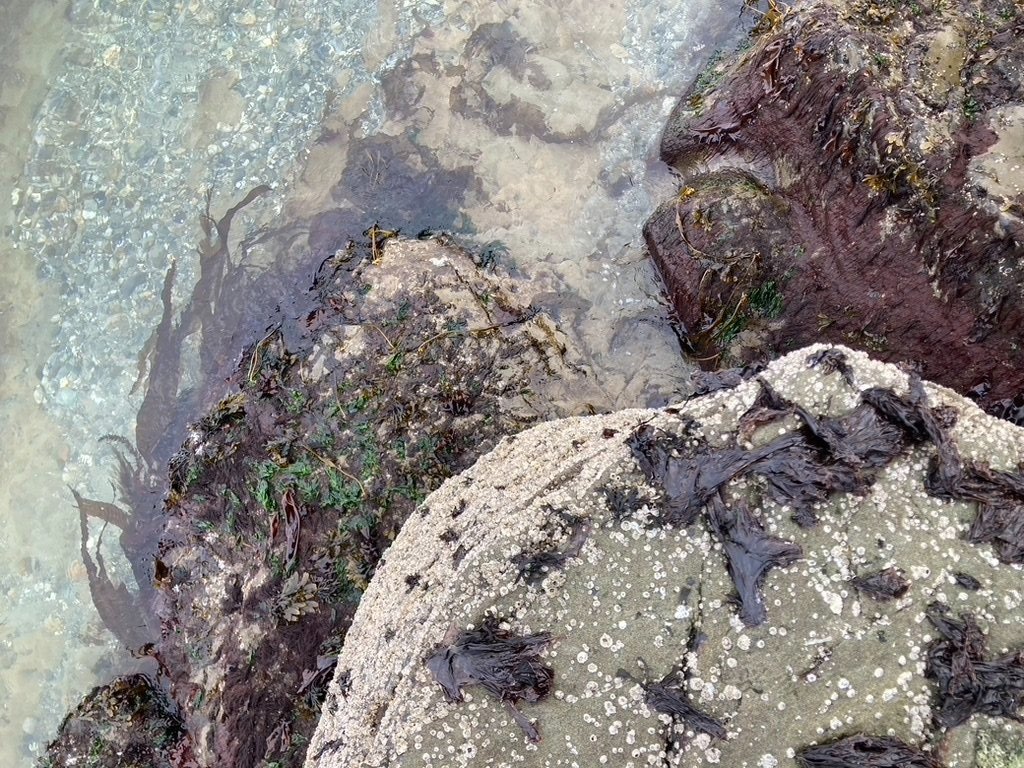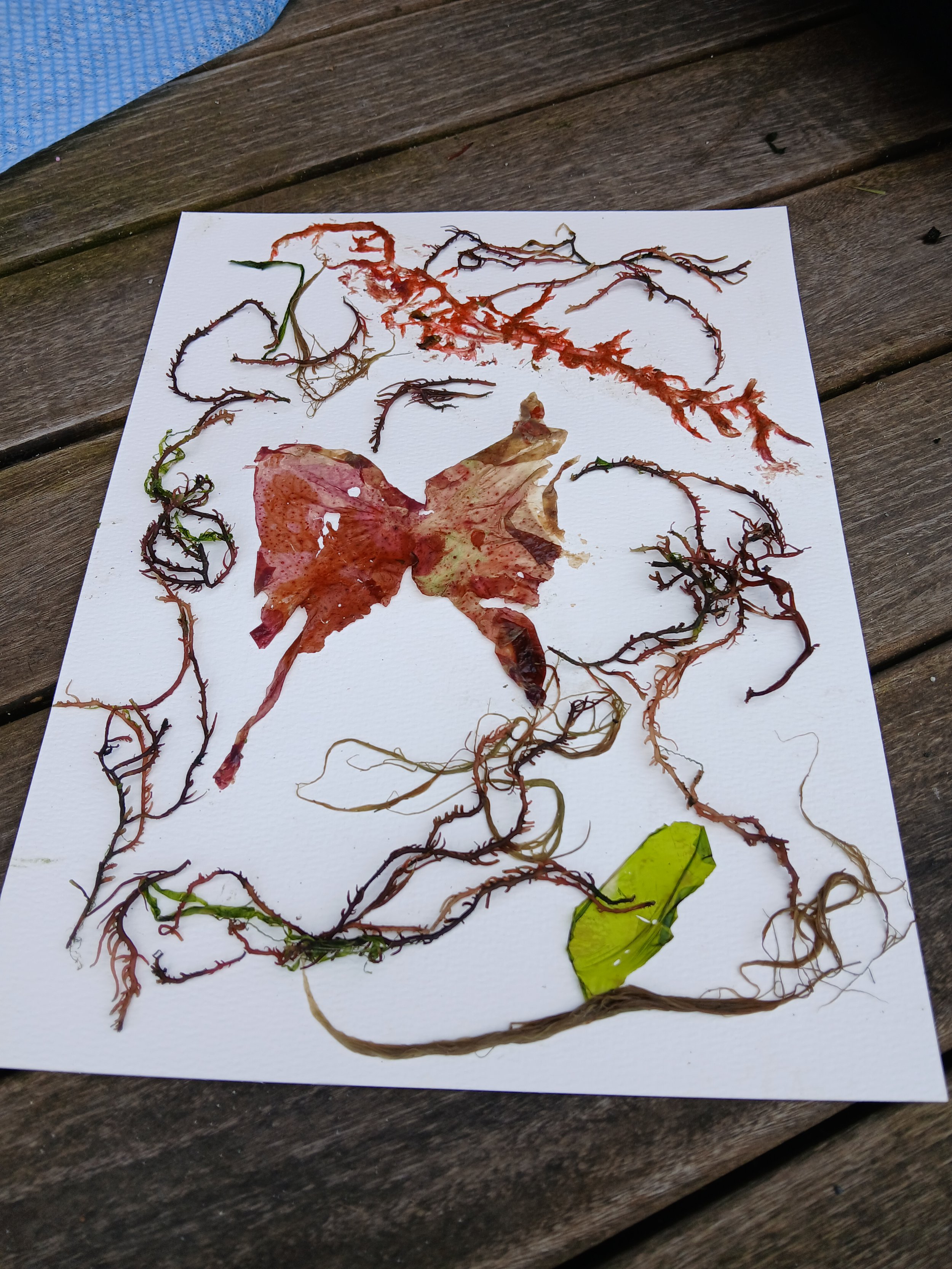
Seaweed
Resources
-

Seaweed Hair Rinse and Bath Instructions
-

How to Make Kelp Pickles
-

Red Seaweed Gel Extraction Instructions
-

Seaweed Drying Instructions
-

Seaweed Artwork Instructions
For seaweed class students and enthusiasts alike, I have compiled a list of resources for where to buy seaweed, seaweed books, studies, radiation and more. Please check these out!
Seaweed Education with Kristy Bredin
Upcoming field and online Seaweed Classes
Marine Herbalism Class Recording
Top 10 Ways to Make Seaweeds a Part of Your Life Class 10.15.2024
Seaweed Products
Rising Tide Sea Vegetables (CA coast)
Nature Spirit Herbs: wild harvested seaweeds (and some info), herbs, and mushrooms (based in OR)
BC Kelp: Seaweeds harvested off the the remote Queen Charlotte Islands (Haida Gwaii) in BC
Mountain Rose Herbs: A variety of certified organic seaweeds; good source for seaweed flakes and powders.
Salish Sea Greens: Lummi Island farmed seaweeds
Canadian Kelp Seaweeds from Barkley Sound BC. Louis D. Dreuhl’s, author of Pacific Seaweeds, company
Algal Aid: Product using red seaweed gel for topical viral outbreak application. This product seems to no longer be available.
Maine Coast Sea Vegetables: One of the primary reputable seaweed harvesters in Maine. Seaweeds for sale and lots of great learning as well. They also have a large array of seaweed topical products without a lot of additives: https://seaveg.com/collections/bath-body
Landsea Gomasio: Bullwhip kelp-based gomasio condiment made on Orcas Island, WA.
Barnacle Foods: They have kelp pickles and their hot sauce is pretty great too!
Seaweed Fiber Yarn (About Seacell
Nutrient Content in Seaweeds
https://seaveg.com/pages/seaweed-nutrition-facts
Seaweeds and Health
Ryan Drum: In-depth articles on seaweeds as food and medicine. (As of March 2025, Ryan Drum’s site is currently down. We hope to get it back up shortly. Check back in a few weeks.)
Ryan Drum’s story on healing knee cartilage with bladderwack: http://www.ryandrum.com/radiationprotectionusingseaweeds.htm (scroll down to “Jean’s Knees” under External Uses of Seaweeds) (As of March 2025, Ryan Drum’s site is currently down. We hope to get it back up shortly. Check back in a few weeks.)
Old Man and the Seaweed, a documentary on Ryan Drum by David Kaufman
Can Red Marine Algae Help with Shingles, Eczema or cold Sores?
Maine Coast Sea Vegetables Blog
Iodine & Thyroid
The Iodine Crisis, Lynne Farrow
Dr. Izabella Wentz Hashimoto’s Protocol
Aakre, I, L Tveito Evensen, M Kjellevold, L Dahl, S Henjum, J Alexander, L Madsen, and MW Markhus. 2020. “Iodine Status and Thyroid Function in a Group of Seaweed Consumers in Norway.” Nutrients 12 (11): 3483.https://napiers.net/blogs/health-information/how-much-iodine-is-there-in-seaweed
http://www.ryandrum.com/thyroidpart2.htm
Seaweeds and Covid 19
Seaweed ID, Cooking, and more!
Recreational kelp harvest in Smith and Minor Islands aquatic reserve
algaebase.org
seaweedsofpnw.com
https://www.nhbs.com/blog/guide-uk-seaweed-identification
Seaweeds of the Pacific Coast, Jennifer Mondragon
Pacific Seaweeds, Louis Druehl
Common Seaweeds, Robert Waaland
The Sea Vegetable Book, Judith Cooper Madlener
North Pacific Seaweeds, Rita M. O’Clair and Sandra Lindstrom
Field Guide to Seaweeds of Alaska, Mandy R. Lindeberg
Keys to the Seaweeds and Seagrasses of Southeast Alaska, British Columbia, Washington and Oregon
Common Edible Seaweeds in the Gulf of Alaska, Dolly Garza
Prannie Rhatigan, Irish Seaweed Kitchen
Shep Erhart and Leslie Carrier, Sea Vegetable Celebration
Valerie Cooksley, Seaweed
Seaweed Foraging Information, Ireland
https://www.seaweedandco.com/the-benefits-of-dulse-are-making-waves/
https://cdnsciencepub.com/doi/pdf/10.1139/b84-303
https://www.ncbi.nlm.nih.gov/pmc/articles/PMC6266857/
https://link.springer.com/article/10.1007/s10811-013-0014-7
seaweed commons.org
Kitchen Alchemy Blog/Modernist Pantry: a lot of awesome blog entries and videos about working with hydrocolloids (carrageenan, alginate, agar) to create gels. They work with isolated mucopolysaccharides, but some of this information can be applied to whole-form seaweed gel extraction and use. Search blog for “carrageenan” and a lot of great videos and recipes will come up!
Seaweed Artwork
https://www.youtube.com/watch?v=y75dmbiGfHE
https://www.youtube.com/watch?v=3J3zQsYdUek
https://www.youtube.com/watch?v=ZbBQrMWw_LA
Mucopolysaccharides
https://www.ncbi.nlm.nih.gov/pmc/articles/PMC3433884/
http://www.ryandrum.com/seaweeds.htm
http://www.ryandrum.com/seaxpan1.html
Radiation/Pollutants
Kelp Watch: Study of kelp samples from the west coast of the Pacific Ocean (Alaska-California) for Fukushima-specific radiation.
Our Radioactive Ocean: Post-Fukushima maps and data on radiation levels over time on the west coast of the Pacific Ocean (Alaska-California) since the Fukushima nuclear disaster.
Heavy Metals and Living Systems: An Overview
Heavy Metal Exposures and Alzheimer’s Disease and Related Dementias
Jennifer Hahn’s Chemical Contaminant Levels in Edible Seaweeds of the Salish Sea and Implications for Their Consumption
Salish Sea Activism
Puget Sound Restoration Fund: Projects throughout Puget Sound to restore marine resources and create healthy ecosystems. Bullwhip Kelp Restoration Project
Puget Soundkeeper: Initiatives to tackle pollution of Puget Sound waters from a wide range of sources, such as industrial agriculture, sewage, fossil fuel production, and stormwater runoff.
Bullwhip Kelp Story Map: Map of historical kelp beds in the San Juan Islands compiled through Samish Tribe oral tradition.
SeaTrees: Restoring Coastal Ecosystems